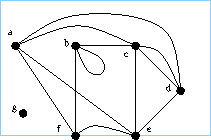 %Exercise:
%It will be useful to
% represent a graph $g$ on a countable vertex set by a picture.
A plane drawn picture
$d = \ppic$
is a closed rectangular interval of the plane $R$ together with
a label set $V$, an injective map
$\lambda : V \rightarrow R$, and a subset $S$ of $R$
consisting of smoothly embedded line intervals terminating at
certain of the marked points $\lambda: V$.
%Exercise:
%It will be useful to
% represent a graph $g$ on a countable vertex set by a picture.
A plane drawn picture
$d = \ppic$
is a closed rectangular interval of the plane $R$ together with
a label set $V$, an injective map
$\lambda : V \rightarrow R$, and a subset $S$ of $R$
consisting of smoothly embedded line intervals terminating at
certain of the marked points $\lambda: V$.
An alcove of such a picture $\ppic$ is a connected component of $R \setminus S$. (See also here.) A set of line interval embeddings is generic if when two lines meet at an unmarked point the tangents do not coincide; (we may also require that no third line passes through such a point;) and no line meets a marked point except at an endpoint.
In order to represent a graph $g=(V,E,f)$ by such a picture $\ppic$,
one proceeds as follows.
First one draws marked points such that each may be identified with a
vertex in $V$.
Each edge $\epsilon$ in $E$ is then represented by a line interval
between the vertices in $f(\epsilon)$, and labelled by $\epsilon$.
There is much freedom of choice in this, but one wants
that a complete single line can be determined unambiguously from the
drawn set of lines.
To this end the set of line interval embeddings is
chosen to be
generic.
(This is sophistry, in that it is not really possible to determine
tangents to lines by looking at drawn pictures, except within some tolerance.
Thus if we use pictures in practice, tangents must not only be
different, but sufficiently different.)
In such a picture we shall call the boundary of the rectangular region the frame . A vertex may lie on the frame (call such a vertex exterior), but by convention a line interval may touch the frame only at its endpoints.